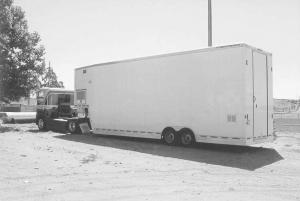2004 - Volume #28, Issue #5, Page #09
[ Sample Stories From This Issue | List of All Stories In This Issue | Print this story
| Read this issue]
"Slaughter House On Wheels"
 |
 |
"We fit real well into the æbuy fresh, buy local' statewide campaign here," says rancher George Work of San Miguel, Calif.
Government grants totaling $188,750 were used by the "Central Coast Home Grown Meat Alliance" to put the mobile processor together and to pay for training, surveys and producer education in Obispo and Monterey counties.
"There are about 50 people in all who are interested in joining the alliance or forming a co-operative," Work explains. "All of those details are currently being worked out."
The group had the custom-designed, 26-ft.-long gooseneck unit built for them by Featherlight Trailers. The portable butcher shop has an interior height of 10 ft. 6 in. Cattle are slaughtered in the unit but cutting and wrapping are done elsewhere.
The plant is completely self-sufficient, generating its own electricity with a 10KW generator. It carries its own water and provides on-board chilling and storage space for carcasses (up to 10 steers, 40 lambs, or 20 hogs.)
The rig allows partners in the project to keep their cattle on the farm right up until slaughter, never threatening their organic status, and giving them more control into how humanely the animals are handled. Not needing to transport them lowers their stress, and improves meat quality, they say.
According to Work, the unit is currently waiting for USDA inspection and approval, and the assignment of a meat inspector.
This mobile slaughter facility was modeled after one established earlier by a farmers' co-op at Lopez Island, Wash.
The killing occurs outside the trailer. Then an electric winch lifts the animal into an open-sided, metal cradle where it is skinned and gutted. Offal is collected in a tractor front-end loader to be composted on the farm.
Work says the unit can be used to slaughter five beef cattle per day and four times as many sheep or two times as many hogs.
Both a butcher and a USDA meat inspector travels with the unit from farm to farm. Once the freshly slaughtered meat has been stamped with the USDA label, producers may sell it direct to grocery stores and restaurants, or take it to a USDA-certified processing plant to have it cut and wrapped, before selling directly to consumers.
Ranchers expect to increase their net income by cutting out the retail middlemen and earn premium prices for their product.
The USDA pays for inspection, but there is a fee for carcass grading. A fee schedule for the on-farm slaughtering service has not yet been set.
Contact: FARM SHOW Followup, George Work, 75903 Ranchita Canyon Rd., San Miguel, Calif. 93451 (ph 805 467-3233; email: geoelainework@thegrid.net).

Click here to download page story appeared in.

Click here to read entire issue
To read the rest of this story, download this issue below or click here to register with your account number.




